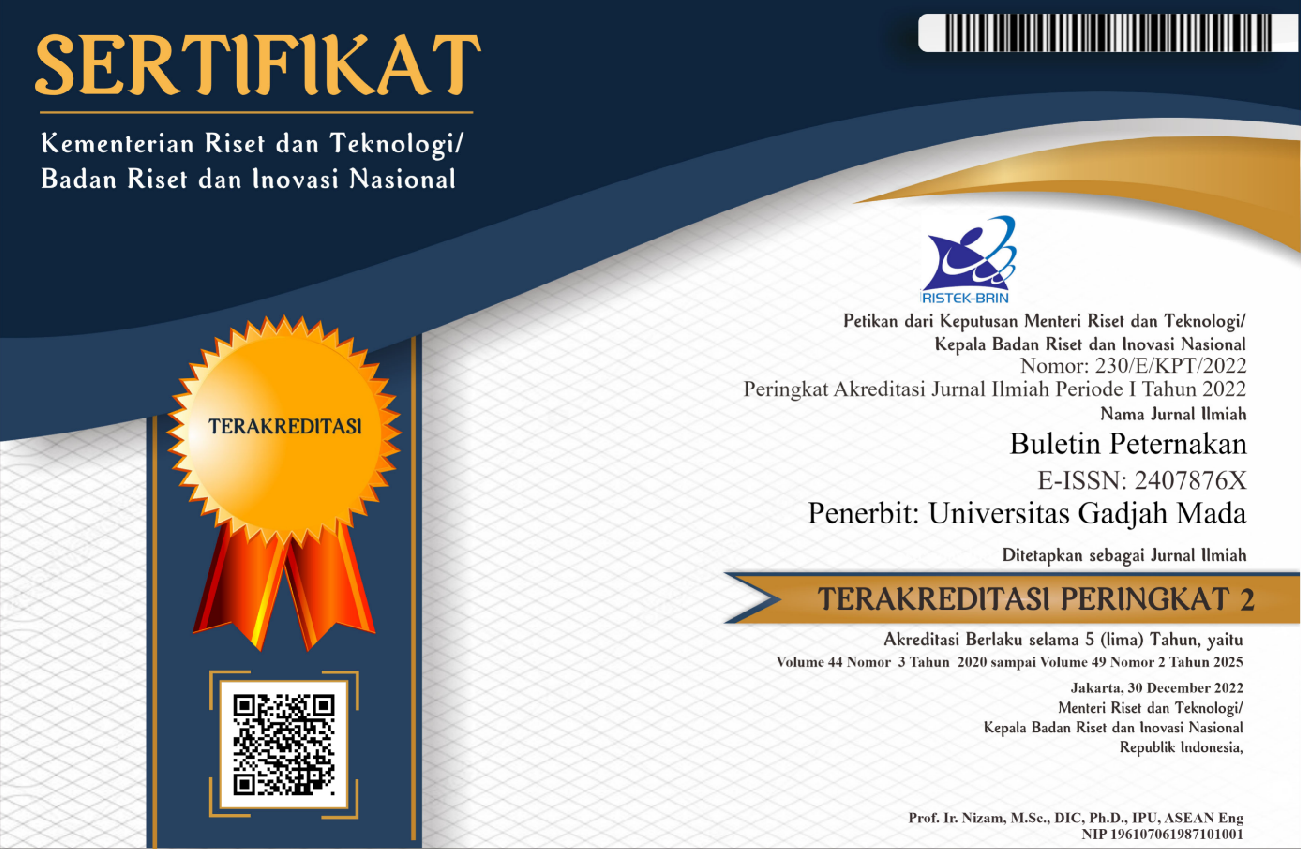The Effect of Age on the Quality of Semen Turkeys (Meleagris gallopavo)
Riyan Nugroho Aji(1*), Ismaya Ismaya(2), Sri Harimurti(3), Heru Sasongko(4), Sigit Bintara(5), Widya Asmarawati(6)
(1) Faculty of Animal Science, Universitas Gadjah Mada, Yogyakarta, 55281, Indonesia
(2) Faculty of Animal Science, Universitas Gadjah Mada, Yogyakarta, 55281, Indonesia
(3) Faculty of Animal Science, Universitas Gadjah Mada, Yogyakarta, 55281, Indonesia
(4) Faculty of Animal Science, Universitas Gadjah Mada, Yogyakarta, 55281, Indonesia
(5) Faculty of Animal Science, Universitas Gadjah Mada, Yogyakarta, 55281, Indonesia
(6) Faculty of Animal Science, Universitas Gadjah Mada, Yogyakarta, 55281, Indonesia
(*) Corresponding Author
Abstract
The purpose of this study was to observe the macroscopic and microscopic quality of Bronze turkey fresh semen on various ages. The observed toms were at the ages of 9 to 10 months (P1), 13 to 14 months (P2), and 17 to 18 months (P3), with each taken from 3 different toms. The collection was done by abdominal massage, and collected for 3 times a week in triplicate. This data was analyzed by analysis of variance (ANOVA) in a completely randomized design, followed by Duncan's New Multiple Range Test (DMRT) if there was any difference. The results showed that the average volume of turkey fresh semen were P1 (0.16 ± 0.04 ml), P2 (0.13 ± 0.02 ml), and P3 (0.10 ± 0.02 ml). The average pH of fresh semen were P1 (7.19 ± 0.05), P2 (7.12 ± 0.10), and P3 (7.06 ± 0.06). The average motility percentage of fresh semen were P1 (78.11 ± 1.38%), P2 (82.55 ± 1.17%), and P3 (74.55 ± 4.16%). The average viability percentage of fresh semen were P1 (78.63 ± 1.55%), P2 (83.26 ± 1.54%), and P3 (79.20 ± 1.06%). The average abnormal percentage of spermatozoa were P1 (3.01 ± 0.04%), P2 (3.04 ± 0.88%), and P3 (3.21 ± 0.44%). In conclusion, the best fresh semen quality is found on toms aged from 13 to14 months (P2). Furthermore, at the age 17 to18 months and more, the semen quality was decreased.
Keywords
Full Text:
PDFReferences
Anandh, M. A. and P. N. R. Jagatheesan. 2015. Reproductive performance of beltsville small white and broad breasted bronze turkeys (Melleagris gallopavo) under hot humid climatic condition. Indian J. Anim. Res. 49: 847–850.
Dimitrov, S. G., V. K. Atanasov, P. F. Surai, and S. A. Denev. 2007. Effect of organic selenium on turkey semen quality during liquid storage. Anim. Reprod. Sci. 100:
311–317.
Douard, V., D. Hermier, M. Magistrini, and E. Blesbois. 2003. Reproductive period affects lipid composition and quality of fresh and stored spermatozoa in turkeys. Theriogenology 59: 753–764.
Douard, V., D. Hermier, C. Labbe, M. Magistrini, and E. Blesbois. 2005. Role of seminal plasma in damage to turkey spermatozoa during in vitro storage. Theriogenology 63: 126–137.
Dumpala, P. R., H. M. Parker, and C. D. McDaniel. 2006. The effect of semen storage temperature and diluent type on the semen quality index of broiler breeder semen. Int. J. Poult. Sci. 5: 838–845.
Etches, R. J. 1996. Reproduction in Poultry. CAB International. University Press, Cambridge.
Hafez, E. S. E. 1993. Reproduction in Farm Animals. 6th edn. Lea and Febiger, Philadelpia.
Laffaldano, N., L. Romagnoli, A. Manchisi, and M. P. Rosato. 2011. Cryopreservation of turkey semen by the pellet method: Effects of variables such as the extender, cryoprotectant concentration, cooling time and warming temperature on semen quality determined through principal components analysis. Theriogenology 76: 794–801
Mathevon, M., M. Buhr and J. C. M. Dekkers. 1998. Environmental, managementand genetic factors affecting semen production in Holstein bulls. J. Dairy Sci. 81: 3321–3330.
Nalbandov, A. V. 1990. Fisiologi Reproduksi Mamalia dan Unggas.Terjemahan Sunaryo Keman. Penerbit Universitas Indonesia, Jakarta. Pp: 247–267.
Samsudewa, D., M. I. S. Wuwuh and Y. S. Ondho. 2007. Pengaruh jumlah spermatozoa per inseminasi terhadap kualitas semen beku kambing Peranakan Etawa. Seminar Nasional Teknologi Peternakan dan Veteriner Fakultas Peternakan Universitas Diponegoro, Semarang. Available at http://digilib.litbang.deptan.go. id. Accession date 4th june 2014.
Słowinska, M,. E. Liszewska, G.J. Dietrich, and A. Ciereszko. 2012. Characterization of proacrosin/acrosin system after liquid storage and cryopreservation of turkey semen (Meleagris gallopavo). Theriogenology 78: 1065–1077.
Suharyati, S. 2006. Pengaruh penambahan vitamin E dan mineral Zn terhadap kualitas semen serta fertilitas dan daya tetas telur kalkun lokal. J. Indon. Trop. Anim. Agric. 31: 179–183.
Susilawati, T., P. Srianto, Hermanto, dan E. Yuliani. 2003. Inseminasi buatan dengan spermatozoa beku hasil sexing pada sapi untuk mendapatkan anak dengan jenis kelamin sesuai harapan. Laporan Penelitian. Fakultas Peternakan, Universitas Brawijaya, Malang.
Toelihere, M. R. 1993. Inseminasi Buatan pada Ternak. Angkasa. Bandung.
Wahyudi, L., T. Susilawati, dan N. Isnaini. 2014. Tampilan reprodiksi hasil inseminasi buatan menggunakan semen beku hasil sexing pada sapi Persilangan Ongole di peternak rakyat. J. Ternak Trop. 15: 80-88.
Wahyuni, A. 2002. Pengaruh solasodin terhadap diameter tubulus seminiferus dan gambaran sel-sel semen togenik mencit (Mus musculus) dewasa. Jurnal Kedokteran Yarsi 10: 56 – 65.
Widiatmoko, F., T. Kurtini, dan K. Nova. 2014. Pengaruh Umur Induk Terhadap Fertilitas, Susut Tetas, Daya Tetas, dan Bobot Tetas Telur Kalkun. JIPT. 2: 11–15
Zaniboni, L., R. Rizzi, and S. Cerolini. 2006. Combined effect of DHA and a-tocopherol enrichment on semen quality and fertility in the turkey. Theriogenology 65: 1813-1827.
Article Metrics
Refbacks
- There are currently no refbacks.

This work is licensed under a Creative Commons Attribution-ShareAlike 4.0 International License.
Buletin Peternakan (Bulletin of Animal Science) Indexed by:

This work is licensed under a Creative Commons Attribution-ShareAlike 4.0 International License.









